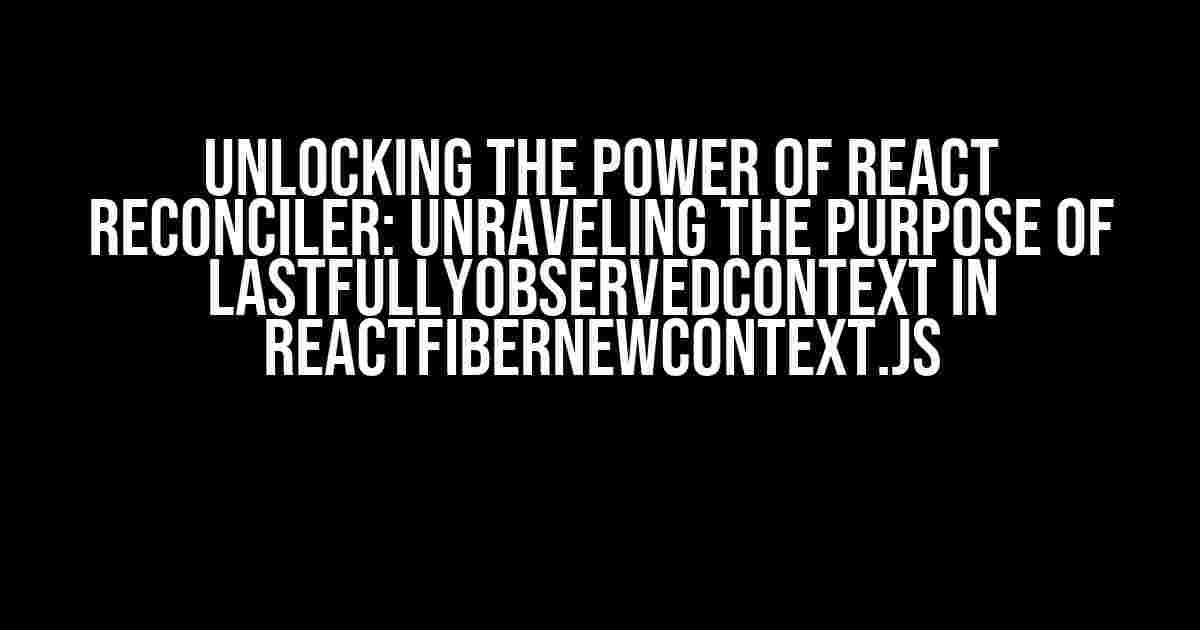React, the popular JavaScript library, has been a game-changer in the world of front-end development. However, beneath its surface lies a complex architecture that can be overwhelming, especially for developers new to the ecosystem. One such concept that often raises eyebrows is the React Reconciler, specifically the `lastFullyObservedContext` in `ReactFiberNewContext.js`. In this article, we’ll delve into the mysteries of React Reconciler, exploring the purpose of `lastFullyObservedContext` and its significance in the grand scheme of React’s architecture.
What is React Reconciler?
Before diving into the nitty-gritty of `lastFullyObservedContext`, it’s essential to understand the React Reconciler. The Reconciler is responsible for updating the DOM by comparing the previous and next versions of the virtual DOM. This process, known as reconciliation, involves identifying the differences between the two versions and applying the necessary changes to the real DOM.
The Reconciler is the backbone of React’s architecture, ensuring efficient and optimized rendering of components. It’s a complex algorithm that involves multiple phases, including:
- Render phase: Generating the virtual DOM
- Commit phase: Updating the real DOM
- WorkInProgress (WIP) phase: Preparing the next update
The Role of Context in React
In React, context is a mechanism that allows components to share data without passing props down manually. Context providers create a scope where components can access shared data. This approach simplifies state management and makes it easier to build complex applications.
To understand `lastFullyObservedContext`, we need to explore how context works in React:
- A context provider creates a scope for its descendants
- Components within the scope can access the shared data using the `useContext` hook
- When the context changes, React re-renders the affected components
LastFullyObservedContext: Unveiling its Purpose
Now that we’ve covered the basics of React Reconciler and context, let’s dive into the `lastFullyObservedContext` in `ReactFiberNewContext.js`. This property is part of the Fiber data structure, which represents a component’s instantiation in memory.
`lastFullyObservedContext` is responsible for tracking the most recent context value observed by a component during reconciliation:
const lastFullyObservedContext = context_value_at-commit-time;
When React reconciles a component, it compares the current context value with the `lastFullyObservedContext`. If the values differ, React marks the component as needing an update.
Why is LastFullyObservedContext Important?
So, why does React need to keep track of the `lastFullyObservedContext`? Here are some key reasons:
- Optimized rendering**: By keeping track of the last observed context, React can avoid unnecessary re-renders when the context hasn’t changed.
- Context memoization**: Memorizing the last observed context value enables React to skip recalculating the context value for unchanged components.
- Efficient subscription management**: `lastFullyObservedContext` helps React manage subscriptions to context changes, ensuring that components are only re-rendered when necessary.
How Does LastFullyObservedContext Work?
To understand the inner workings of `lastFullyObservedContext`, let’s dissect the ReactFiberNewContext.js file. This file is responsible for creating a new context object, which is then passed to the Reconciler.
function createNewContext(): Context {
// ...
const context = {
// ...
lastFullyObservedContext: null,
};
// ...
}
When a component is rendered, React creates a new context object and sets the `lastFullyObservedContext` to `null`. During reconciliation, React checks if the component’s context has changed by comparing the current context value with the `lastFullyObservedContext`.
function reconcileContext(
workInProgress: Fiber,
renderLint: any,
context: Context,
) {
// ...
const currentContext = workInProgress.memoizedContext;
if (currentContext !== lastFullyObservedContext) {
// Mark the component as needing an update
}
// ...
}
If the context has changed, React marks the component as needing an update, and the Reconciler will re-render the component with the new context value.
Best Practices for Working with LastFullyObservedContext
When working with `lastFullyObservedContext`, keep the following best practices in mind:
- Use memoization**: Memoize context values to avoid recalculating them unnecessarily.
- Update context carefully**: Only update the context when necessary to avoid unnecessary re-renders.
- Avoid context nesting**: Minimize context nesting to reduce the complexity of context management.
- Test thoroughly**: Ensure your application behaves as expected by testing context changes extensively.
Conclusion
In conclusion, `lastFullyObservedContext` is a crucial component of React’s architecture, ensuring efficient and optimized rendering of components that rely on context. By understanding its purpose and inner workings, developers can better manage context changes and build more robust applications.
| Key Takeaways | Description |
|---|---|
| React Reconciler | The algorithm responsible for updating the DOM by comparing the previous and next versions of the virtual DOM. |
| LastFullyObservedContext | A property in ReactFiberNewContext.js that tracks the most recent context value observed by a component during reconciliation. |
| Context in React | A mechanism that allows components to share data without passing props down manually. |
| Best Practices | Use memoization, update context carefully, avoid context nesting, and test thoroughly to ensure efficient context management. |
Now that you’ve unlocked the secrets of `lastFullyObservedContext`, go forth and build React applications that are fast, efficient, and scalable!
Frequently Asked Question
Unravel the mysteries of React Reconciler’s lastFullyObservedContext in ReactFiberNewContext.js!
What is the purpose of lastFullyObservedContext in ReactFiberNewContext.js?
lastFullyObservedContext is used to keep track of the context that was fully observed by React’s reconciliation algorithm. It’s essential for maintaining the correct context state during the rendering process, especially when dealing with context changes and memoization.
Why is lastFullyObservedContext necessary for React’s reconciliation algorithm?
lastFullyObservedContext helps React’s reconciliation algorithm to determine which parts of the virtual DOM need to be re-rendered when the context changes. By keeping track of the last fully observed context, React can efficiently update the DOM and ensure that components receive the correct context values.
How does lastFullyObservedContext affect memoization in React?
lastFullyObservedContext plays a crucial role in memoization by allowing React to cache context-dependent values correctly. When the context changes, React uses lastFullyObservedContext to invalidate the cached values and re-compute them with the new context. This ensures that memoized values are always up-to-date and reflect the latest context changes.
What happens if lastFullyObservedContext is not updated correctly?
If lastFullyObservedContext is not updated correctly, it can lead to incorrect rendering, stale props, and inconsistent behavior in React applications. This can cause errors, inconsistencies, and performance issues, making it essential to ensure that lastFullyObservedContext is updated accurately and consistently.
Can I customize or override the behavior of lastFullyObservedContext in my React application?
While it’s technically possible to customize or override the behavior of lastFullyObservedContext, it’s not recommended, as it’s a critical internal mechanism in React’s reconciliation algorithm. Modifying or overriding it can lead to unintended consequences and errors. Instead, focus on using React’s built-in APIs and best practices to ensure correct and efficient rendering.



